The following is an excerpt from the Tattoo History Source Book:
A History of Japanese Tattooing
5,000 BC
The earliest evidence of tattooing in Japan is found in the form of clay
figurines that have faces painted or engraved to represent tattoo marks. The
oldest figures of this kind have been recovered from tombs dated to 5,000 BC or
older.
|
|
297 AD
The first written record of Japanese tattooing was discovered when a Chinese dynastic
history was compiled. According to the text, Japanese "men young and old, all
tattoo their faces and decorate their bodies with designs." Japanese tattooing
is also mentioned in other Chinese histories, but almost always in a negative context.
The Chinese considered tattooing to be a sign of barbarism and used it only as
punishment. |
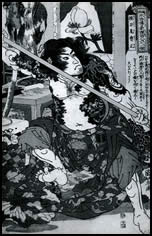 7th Century
7th Century
By the time of early seventh century, the rulers of Japan had adopted much of the
same culture, style and attitude of the Chinese, and as a result decorative tattooing fell
into official disfavor.
720AD
The first record of Japanese tattooing as punishment was mentioned in a history.
that reads: "The Emperor summoned before him Hamako, Muraji of Azumi and
commanded him saying: You have plotted to rebel and overthrow the state. This
offence is punishable by death. I shall, however, confer great mercy on you by
remitting the death penalty and sentence you to be tattooed."
17th
Century
By the early seventeenth century, there was a generally accepted codification of
tattoo marks used to identify criminals and outcasts in Japan. Outcasts were
tattooed on the arms: a cross might be tattooed on the inner forearm, or a
straight line on the outside of the forearm or on the upper arm.
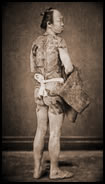 Criminals were marked with a variety of symbols that designated the places
where the crimes were committed. In one region, the pictograph for "dog" was
tattooed on the criminal's forehead. Other marks included patterns which
included bars, crosses, double lines, and circles on the face and arms.
Tattooing was reserved for those who committed serious crimes, and individuals
bearing tattoo marks were ostracized by their families and denied all
participation in community life. For the Japanese, tattooing was a very severe
and terrible form of punishment.
Criminals were marked with a variety of symbols that designated the places
where the crimes were committed. In one region, the pictograph for "dog" was
tattooed on the criminal's forehead. Other marks included patterns which
included bars, crosses, double lines, and circles on the face and arms.
Tattooing was reserved for those who committed serious crimes, and individuals
bearing tattoo marks were ostracized by their families and denied all
participation in community life. For the Japanese, tattooing was a very severe
and terrible form of punishment.
By the end of the seventeenth century, penal tattooing had been largely
replaced by other forms of punishment. One is reason is that decorative
tattooing became popular, and criminals covered their penal tattoos with larger
decorative tattoos. This is also thought to be the historical origin of the
association of tattooing and organized crime in Japan.
The earliest reports of decorative tattooing are found in fiction published
toward the end of the seventeenth century.
18th Century
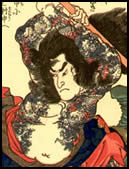 Pictorial
tattooing flourished during the eighteenth century in connection with the
popular culture of Edo, as Tokyo was then called. Early in the 18th century,
publishers needed illustrations for novels, theatres needed advertisements for
their plays and the Japanese wood block print was developed to meet these needs.
The development of the wood block print parallels, and had great influence on,
the development of the art of tattooing. Because of the association between tattooing and
criminal activity, tattooing was outlawed on the grounds that it was "deleterious
to public morals."
Pictorial
tattooing flourished during the eighteenth century in connection with the
popular culture of Edo, as Tokyo was then called. Early in the 18th century,
publishers needed illustrations for novels, theatres needed advertisements for
their plays and the Japanese wood block print was developed to meet these needs.
The development of the wood block print parallels, and had great influence on,
the development of the art of tattooing. Because of the association between tattooing and
criminal activity, tattooing was outlawed on the grounds that it was "deleterious
to public morals."
Tattooing continued to flourish among firemen, laborers and others considered
to be at the lower end of the social scale. Tattoos were favored by gangs called
Yakuza, outlaws, penniless peasants, laborers and misfits who migrated to Edo in
the hope of improving their lives.
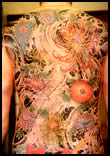 The Yakuza felt that because tattooing was painful, it was a proof of
courage; because it was permanent, it was evidence of lifelong loyalty to the
group; and because it was illegal, it made them outlaws forever.
The Yakuza felt that because tattooing was painful, it was a proof of
courage; because it was permanent, it was evidence of lifelong loyalty to the
group; and because it was illegal, it made them outlaws forever.
Around the middle of the 18th century, the popularity of tattooing was
stimulated by a popular Chinese novel, Suikoden, with many of its novel's heroes
extensively tattooed. The Japanese version of Suikoden was illustrated by a
variety of artists, each of whom created prints with new interpretations of the
tattoos described in the novel.
This novel and the new illustrations influenced all Japanese arts and
culture.
19th Century
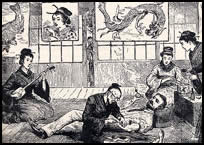 By
1867, the last of the Tokugawa shoguns was deposed and an emperor was restored
to power. The laws against tattooing were strictly enforced because the new
rulers feared that Japanese customs would seem barbaric and ridiculous to
Westerners. Ironically, under the new laws Japanese tattoo artists were allowed
to tattoo foreigners but not Japanese. The best tattoo masters established
studios in Yokohama and did a lot of business tattooing foreign sailors. Their
skills were so great that they attracted a number of very distinguished clients
including the Duke of York (Later King George V), the Czarevich of Russia (Later
Czar Nicholas II), and other European dignitaries.
By
1867, the last of the Tokugawa shoguns was deposed and an emperor was restored
to power. The laws against tattooing were strictly enforced because the new
rulers feared that Japanese customs would seem barbaric and ridiculous to
Westerners. Ironically, under the new laws Japanese tattoo artists were allowed
to tattoo foreigners but not Japanese. The best tattoo masters established
studios in Yokohama and did a lot of business tattooing foreign sailors. Their
skills were so great that they attracted a number of very distinguished clients
including the Duke of York (Later King George V), the Czarevich of Russia (Later
Czar Nicholas II), and other European dignitaries.
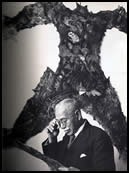 The Japanese tattoo masters also continued to tattoo Japanese clients
illegally, but after the middle of the 19th century, their themes and techniques
remained unchanged. Classical Japanese tattooing is limited to specific designs
representing legendary heroes and religious motifs which were combined with
certain symbolic animals and flowers and set off against a background of waves,
clouds and lightning bolts.
The Japanese tattoo masters also continued to tattoo Japanese clients
illegally, but after the middle of the 19th century, their themes and techniques
remained unchanged. Classical Japanese tattooing is limited to specific designs
representing legendary heroes and religious motifs which were combined with
certain symbolic animals and flowers and set off against a background of waves,
clouds and lightning bolts.
The original designs used in Japanese tattooing were created by some of the
best ukiyoe artists. The tattoo masters adapted and simplified these designs to
make them suitable for tattooing, but didn't invent the designs on their own.
Traditional Japanese tattoo differs from Western tattoos in that is consists
of a single major design that covers the back and extends onto the arms, legs
and chest. The design requires a major commitment of time, money and emotional
energy.
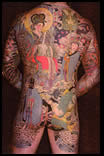 During most of the 19th century, an artist and a tattooist worked together.
The artist drew the picture with a brush on the customer's skin, and the
tattooist just copied it.
During most of the 19th century, an artist and a tattooist worked together.
The artist drew the picture with a brush on the customer's skin, and the
tattooist just copied it.
20th Century
In 1936, when fighting broke out in China, almost all the men were drafted into
the army. People with tattoos were thought to be discipline problems, so they
weren't drafted and the government passed a law against tattooing. After that
the tattooists had to work in secret. After WWII, General MacArthur liberalized
the Japanese laws, and tattooing became legal again. But the tattoo artists
continued to work privately by appointment, and this tradition continues today.
Click for more photos
Tattoo Museum Bibliography, Resources and Links
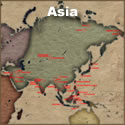 See all Asian Tattoo Culture Articles here
See all Asian Tattoo Culture Articles here
Additional Resources
Wen Shen: The Vanishing Art of Chinese Tribal Culture
The Tattooed Headhunters of Taiwan
At The Tail of the Dragon: The Vanishing Tattoos of
China's Li People
Tattooing Among Japan's Ainu People
Japanese tattoo designs and symbols - what do they mean?
Tattoo
in Chinese history -- tattoo is called "Wen Shen" or
"Ci Shen" in Chinese. The term means literally "puncture
the body".
History-induced Stigma: The Role of Tattoos in Japanese Society
-- Excellent overview of the history of tattooing in Japan, the
current feelings about having a tattoo and much more! Well written and
researched -- recommended reading!
The
Art of the Japanese Tattoo -- The
Japanese tattoo is an ancient art. Haniwa, small clay figurines, some
bearing facial tattoos, have been found in tombs that date from the
fourth or fifth century. It is thought that the tattoo signified social
rank or warded off evil spirits and wild animals. Over time, the custom
faded and it became the fate of criminals, in the old Chinese manner, to
be tattooed on the face as a form of punishment.
Tattoo
History and Culture in early Japan -- The most comprehensive record of early Japan that remains was written by the Chinese some time before A.D. 300. It portrays the Japanese as law-abiding people, fond of drink, concerned with divination and ritual purity, familiar with agriculture (including wet-rice cultivation), expert at fishing and weaving, and living in a society where social differences were expressed through the use of tattooing or other bodily markings.
